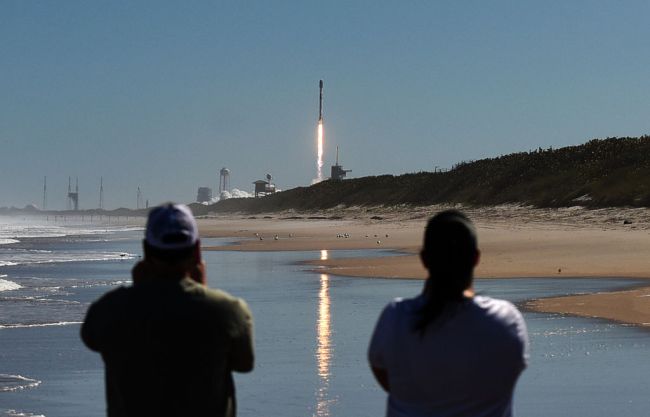
Getty Image / SOPA Images / Contributor
SpaceX expects to lose dozens Starlink satellites only days after launching them into orbit. The dozens of Starlink satellites were reportedly lost after a geomagnetic storm disabled the state-of-the-art internet-delivery equipment.
On February 3, SpaceX utilized a Falcon 9 rocket at the Kennedy Space Center in Florida to launch 49 Starlink satellites into low Earth orbit. However, only days after putting the high-speed internet satellites into orbit, a geomagnetic storm disabled 40 of the 49 satellites.
The National Oceanic and Atmospheric Administration defines a “geomagnetic storm” as a “major disturbance of Earth’s magnetosphere that occurs when there is a very efficient exchange of energy from the solar wind into the space environment surrounding Earth.”
“These storms result from variations in the solar wind that produces major changes in the currents, plasmas, and fields in Earth’s magnetosphere,” the NOAA stated. “The solar wind conditions that are effective for creating geomagnetic storms are sustained (for several to many hours) periods of high-speed solar wind, and most importantly, a southward directed solar wind magnetic field (opposite the direction of Earth’s field) at the dayside of the magnetosphere. This condition is effective for transferring energy from the solar wind into Earth’s magnetosphere.”
Elon Musk’s space company released a statement of the lost satellites.
“Unfortunately, the satellites deployed on Thursday were significantly impacted by a geomagnetic storm on Friday,” SpaceX stated. “These storms cause the atmosphere to warm and atmospheric density at our low deployment altitudes to increase.”
“In fact, onboard GPS suggests the escalation speed and severity of the storm caused atmospheric drag to increase up to 50% higher than during previous launches,” the space exploration company noted. “The Starlink team commanded the satellites into a safe-mode where they would fly edge-on (like a sheet of paper) to minimize drag—to effectively ‘take cover from the storm’ — and continued to work closely with the Space Force’s 18th Space Control Squadron and LeoLabs to provide updates on the satellites based on ground radars.”
SpaceX said “up to 40 of the satellites will reenter or already have reentered the Earth’s atmosphere.”
SpaceX acknowledged that the “deorbiting satellites pose zero collision risk with other satellites.” The rocket company added, “Atmospheric reentry—meaning no orbital debris is created and no satellite parts hit the ground.”
Tamitha Skov – a research scientist of the Aerospace Corp. – told CNBC, “First, ‘the sun shoots off magnets’ in the form of a storm. The Earth’s magnetic shield dumps the solar storm’s energy into our planet’s upper atmosphere and heats it up, causing it to inflate and become denser. This increases the drag on satellites in low Earth orbit.”
CNBC reported, “There are an average of 1,700 such G1 storms over the course of an 11-year-long solar cycle, according to NOAA data highlighted by Erika Palmerio – a space weather research scientist at Predictive Science, a company that supports solar studies for U.S. government agencies.”
CNBC estimated that the loss of 40 Starlink satellite’s could cost Musk’s SpaceX “upward of $50 million.”
“The company has revealed previously that, when SpaceX reuses its Falcon 9 rockets, the cost per launch is about $28 million to $30 million,” the outlet estimated. “And, for the satellites, the company’s leadership has said that an estimate of $1 million cost per spacecraft was ‘way off.’ At half that estimate — or $500,000 per satellite — the loss of about 40 satellites would be worth around $20 million.”